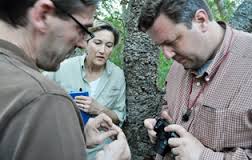 The Tuscaloosa County Master Gardeners will have it’s regular meeting on Tuesday, July 14 at 5:30 P.M. at the Tuscaloosa County Extension Office. Dr. Brian Keener, University of West Alabama, will speak to us about The Alabama Plant Atlas, an online plant database.
The Tuscaloosa County Master Gardeners will have it’s regular meeting on Tuesday, July 14 at 5:30 P.M. at the Tuscaloosa County Extension Office. Dr. Brian Keener, University of West Alabama, will speak to us about The Alabama Plant Atlas, an online plant database.
The Alabama Plant Atlas is a joint effort by the Alabama Herbarium Consortium (AHC) and The University of West Alabama to provide users with a comprehensive searchable database of plants that occur in the state of Alabama.
Alabama, with over 4,000 species of native or naturalized pteridophytes and seed plants, is the fifth most floristically diverse state in the United States. The Alabama Plant Atlas provides a source of information for each species including the distribution within the state using historical and recent data.
Click here to check out The Alabama Plant Atlas
As always, the public is invited to attend.
Update on TCMG Fall Conference
Please mark your calendar to attend the TCMG Annual Fall Conference to be held, Saturday, October 17th from 8:30-2:30 in the County Extension Auditorium. All members are asked to volunteer for one of the following committees so that our guests will enjoy the date. Committees include:
Program Formation-includes speakers, room setup/clean up, technology needs, other logistics as needed-Octavia Miles, Ann Hewitt
Registration and Distribution of Registration Packets-Linda Bagget, Harold Phillips
Table Decorations-Jeanie Gray
Conference Publicity-Pam Sloan, Judith Rives, Amelia Pilsch, Kay Smith
Refreshments and Lunch-Sybil Phillips, Gypsy Kee, Elaine Elmore, Jeanie Gray
Door Prizes-Laurie Reinwald, Brenda Kilgore, Susan Lynch
Preparation of Registration Packets-All executive board and all members as available.
From https://www.houzz.com
Southeast Gardener July Checklist
by Helen Yoest
July is your prize after many months of gardening — from fall prep to spring planning — and you now get to reap your rewards with fresh fruits, vegetables and fragrant flowers. It is a time of abundance.
July is not the best planting month for Southeast gardens, but it’s a good time to plan and prepare. The weeds will not let you rest, but they might slow down to a manageable pace during the dog days of summer. Rainfall will best determine how much time you’ll spend weeding. Little rain, fewer weeds. More rain, more weeds.
Practice wise watering methods: July can be a month with limited rainfall. When nature stops providing regular rain, you may need to supplement. Here are some tips to help your garden during a dry season:
- Chances are your container plants will need to be watered every day. Check by doing the finger test. If the top inch of soil is dry, it’s time to water. Water thoroughly. Small pots will dry out faster than larger pots, and containers in the sun will dry out faster than those in the shade.
- Add mulch. A layer of mulch, 3 to 4 inches deep, will moderate soil temperature and reduce evaporation. Organic mulches include: composted leaves, shredded pine or hardwoods, and even nuggets. Mulches will also reduce weed production and keep the garden looking tidy.
- First season plants — those fall and spring additions — will need more frequent watering than established ones. Water new additions two or three times per week until the plants are established. Established plants typically require watering once a week.
- Conserve water by running a sprinkler during cooler hours, typically early in the morning. This will help reduce water loss due to evaporation. If possible, set up a drip irrigation system or a soaker hose to minimize waste. Watering in the morning hours also allows the water to dry on the foliage, minimizing fungal formation.
Deadhead and deadleaf spent flowers:Remove hosta flowers after the bloom is spent. They’re primarily decorative and not an energy source for the plant, so they don’t need to die back completely before removing. Deadhead the spent flowers of daylilies (Hemerocallis spp.), Shasta daisies (Leucanthemum spp.), black-eyed Susans (Rudbeckia spp.) and bee balm (Monarda spp.) to extend the bloom time.
Divide irises: Did you have success with your new iris planted this year or in the fall? If not, it could be due to several factors: too much shade, too much fertilizer, too deep a planting, or crowding. July is a good time to correct any of these problems by lifting and relocating or repositioning to a more favorable location.
Plant the iris high with the rhizomes along the surface of the dirt. They will be covered finely and lightly with mulch, but not soil. Make sure you can either see the rhizomes or have the ability to brush away the mulch exposing the bulb.
With the exception of Louisiana variety, irises need six to eight hours of sunlight to bloom and require good drainage. If you have a damp, partial sun location in your garden, plant a Louisiana iris.
 Harvest summer edibles: Harvest tomatoes when they are ripe. There is nothing better than sinking your teeth into a ripe tomato, warmed from the summer sun. Didn’t plant tomatoes? Visit your local farmers market for a selection of fresh, field-grown varieties.
Harvest summer edibles: Harvest tomatoes when they are ripe. There is nothing better than sinking your teeth into a ripe tomato, warmed from the summer sun. Didn’t plant tomatoes? Visit your local farmers market for a selection of fresh, field-grown varieties.In your home garden, keep an eye out for early blight. Blight is a fungal disease that will cause spots to develop on the foliage. The leaves begin to yellow and then drop. Pinch off foliage at first indication. If too severe, there are several fungicides that can be used to reduce the symptoms.

Bagworms can be treated by removing them by hand and dropping into a bucket of soapy water. If the bagworm infestation isn’t within easy reach, they can be sprayed with Bacillus thuringiensis, or Bt.
Bt is a microbial insecticide that’s commonly used to control various caterpillars such as the red-headed azalea caterpillar along with many others, as well as bagworms.

 Menu
Menu Search
Search


 Cut back annuals: Cut back summer annuals so they don’t get leggy. A good time to do this is right before you go on vacation; this way, you will be gone as the plants get a fresh start. Petunias benefit from this kind of summer pinch. This cutback from the ends of the stems encourages branching, resulting in a bushier plant.
Cut back annuals: Cut back summer annuals so they don’t get leggy. A good time to do this is right before you go on vacation; this way, you will be gone as the plants get a fresh start. Petunias benefit from this kind of summer pinch. This cutback from the ends of the stems encourages branching, resulting in a bushier plant.






8 best kitchen gardening tips to get started with kitchen gardening that your plants remain healthy and fruitful throughout their life cycle.